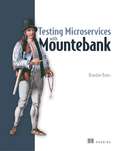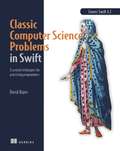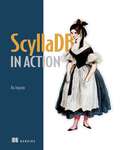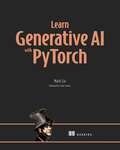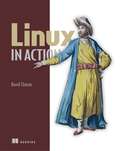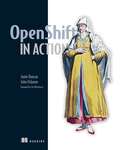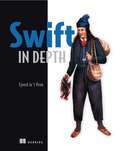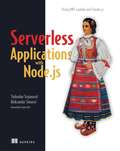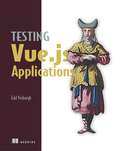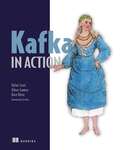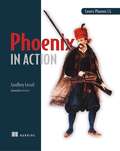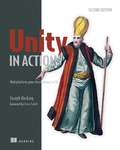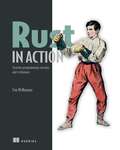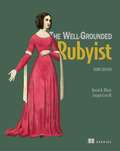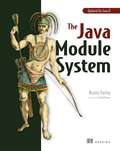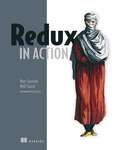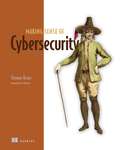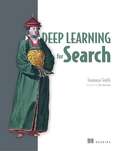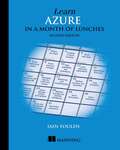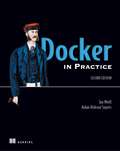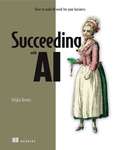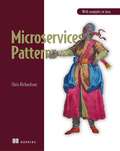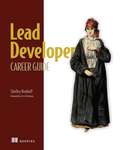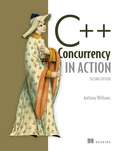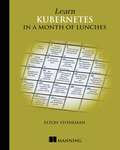- Table View
- List View
Testing Microservices with Mountebank
by Brandon ByarsSummaryTesting Microservices with Mountebank is your guide to the ins and outs of testing microservices with service virtualization. The book offers unique insights into microservices application design and state-of-the-art testing practices that will deepen your microservices skills and improve your applications.Purchase of the print book includes a free eBook in PDF, Kindle, and ePub formats from Manning Publications.About the TechnologyEven if you lab test each service in isolation, it's challenging—and potentially dangerous—to test a live microservices system that's changing and growing. Fortunately, you can use Mountebank to "imitate" the components of a distributed microservices application to give you a good approximation of the runtime conditions as you test individual services.About the BookTesting Microservices with Mountebank introduces the powerful practice of service virtualization. In it, author Brandon Byars, Mountebank's creator, offers unique insights into microservices application design and state-of-the-art testing practices. You'll expand your understanding of microservices as you work with Mountebank's imposters, responses, behaviors, and programmability. By mastering the powerful testing techniques in this unique book, your microservices skills will deepen and your applications will improve. For real.What's insideThe core concepts of service virtualizationTesting using canned responsesProgramming MountebankPerformance testingAbout the ReaderWritten for developers familiar with SOA or microservices systems.About the AuthorBrandon Byars is the author and chief maintainer of Mountebank and a principal consultant at ThoughtWorks.Table of ContentsPART 1 - FIRST STEPSTesting microservicesTaking mountebank for a test drivePART 2 - USING MOUNTEBANKTesting using canned responsesUsing predicates to send different responsesAdding record/replay behaviorProgramming mountebankAdding behaviorsProtocolsPART 3 - CLOSING THE LOOPMountebank and continuous deliveryPerformance testing with mountebank
Classic Computer Science Problems in Swift: Essential techniques for practicing programmers
by David Kopec Ivan MartinovicSummaryClassic Computer Science Problems in Swift invites readers to invest their energy in some foundational techniques that have been proven to stand the test of time. Along the way they'll learn intermediate and advanced features of the Swift programming language, a worthwhile skill in its own right.Purchase of the print book includes a free eBook in PDF, Kindle, and ePub formats from Manning Publications.About the TechnologyDon't just learn another language. Become a better programmer instead. Today's awesome iOS apps stand on the shoulders of classic algorithms, coding techniques, and engineering principles. Master these core skills in Swift, and you'll be ready for AI, data-centric programming, machine learning, and the other development challenges that will define the next decade.About the BookClassic Computer Science Problems in Swift deepens your Swift language skills by exploring foundational coding techniques and algorithms. As you work through examples in search, clustering, graphs, and more, you'll remember important things you've forgotten and discover classic solutions to your "new" problems. You'll appreciate author David Kopec's amazing ability to connect the core disciplines of computer science to the real-world concerns of apps, data, performance, and even nailing your next job interview! What's InsideBreadth-first, depth-first, and A* search algorithmsConstraint-satisfaction problemsSolving problems with graph algorithmsNeural networks, genetic algorithms, and moreAll examples written in Swift 4.1About the ReaderFor readers comfortable with the basics of Swift.About the AuthorDavid Kopec is an assistant professor of computer science and innovation at Champlain College in Burlington, Vermont. He is an experienced iOS developer and the author of Dart for Absolute Beginners.Table of ContentsSmall problems Search problems Constraint-satisfaction problems Graph problems Genetic algorithms K-means clustering Fairly simple neural networks Miscellaneous problems
ScyllaDB in Action
by Bo IngramBuild, maintain, and run databases that are easy to scale and quick to query—all with ScyllaDB.ScyllaDB in Action is your guide to everything you need to know about ScyllaDB, from your very first queries to running it in a production environment. It starts you with the basics of creating, reading, and deleting data and expands your knowledge from there. You&’ll soon have mastered everything you need to build, maintain, and run an effective and efficient database. Inside ScyllaDB in Action you&’ll learn how to: • Read, write, and delete data in ScyllaDB • Design database schemas for ScyllaDB • Write performant queries against ScyllaDB • Connect and query a ScyllaDB cluster from an application • Configure, monitor, and operate ScyllaDB in production This book teaches you ScyllaDB the best way—through hands-on examples. Dive into the node-based architecture of ScyllaDB to understand how its distributed systems work, how you can troubleshoot problems, and how you can constantly improve performance. About the technology ScyllaDB is a versatile NoSQL database that can move large volumes of data fast. Very, very, very fast. This drop-in replacement for Cassandra takes full advantage of modern multi-core hardware and scales to handle large real-time data workloads with incredibly low latency. It features built-in monitoring and management tools, and its efficient use of computing resources can save a lot of money on high-volume applications. About the book ScyllaDB in Action demonstrates how to integrate ScyllaDB into data-intensive applications. You&’ll work through a hands-on project step by step as you use ScyllaDB to store data and learn to configure, monitor, and safely operate a distributed database. Along the way, you&’ll discover how ScyllaDB&’s unique &“shard per core&” approach helps you deliver impressive performance in real-time systems. What's inside • Design schemas for ScyllaDB • Write performant queries • Get an instant speed boost over Cassandra About the reader For backend and infrastructure engineers who know the basics of SQL. About the author Bo Ingram is a staff software engineer at Discord working in database infrastructure. He has extensive experience working with ScyllaDB as an operator and developer. The technical editor on this book was Piotr Wiktor Sarna. Table of Contents Part 1 1 Introducing ScyllaDB 2 Touring ScyllaDB Part 2 3 Data modeling in ScyllaDB 4 Data types in ScyllaDB 5 Tables in ScyllaDB Part 3 6 Writing data to ScyllaDB 7 Reading data from ScyllaDB Part 4 8 ScyllaDB&’s architecture 9 Running ScyllaDB in production 10 Application development with ScyllaDB 11 Monitoring ScyllaDB 12 Moving data in bulk with ScyllaDB Appendix Docker
Learn Generative AI with PyTorch
by Mark LiuLearn how generative AI works by building your very own models that can write coherent text, create realistic images, and even make lifelike music.Learn Generative AI with PyTorch teaches the underlying mechanics of generative AI by building working AI models from scratch. Throughout, you&’ll use the intuitive PyTorch framework that&’s instantly familiar to anyone who&’s worked with Python data tools. Along the way, you&’ll master the fundamentals of General Adversarial Networks (GANs), Transformers, Large Language Models (LLMs), variational autoencoders, diffusion models, LangChain, and more! In Learn Generative AI with PyTorch you&’ll build these amazing models: • A simple English-to-French translator • A text-generating model as powerful as GPT-2 • A diffusion model that produces realistic flower images • Music generators using GANs and Transformers • An image style transfer model • A zero-shot know-it-all agent The generative AI projects you create use the same underlying techniques and technologies as full-scale models like GPT-4 and Stable Diffusion. You don&’t need to be a machine learning expert—you can get started with just some basic Python programming skills. About the technology Transformers, Generative Adversarial Networks (GANs), diffusion models, LLMs, and other powerful deep learning patterns have radically changed the way we manipulate text, images, and sound. Generative AI may seem like magic at first, but with a little Python, the PyTorch framework, and some practice, you can build interesting and useful models that will train and run on your laptop. This book shows you how. About the book Learn Generative AI with PyTorch introduces the underlying mechanics of generative AI by helping you build your own working AI models. You&’ll begin by creating simple images using a GAN, and then progress to writing a language translation transformer line-by-line. As you work through the fun and fascinating projects, you&’ll train models to create anime images, write like Hemingway, make music like Mozart, and more. You just need Python and a few machine learning basics to get started. You&’ll learn the rest as you go! What's inside • Build an English-to-French translator • Create a text-generation LLM • Train a diffusion model to produce high-resolution images • Music generators using GANs and Transformers About the reader Examples use simple Python. No deep learning experience required. About the author Mark Liu is the founding director of the Master of Science in Finance program at the University of Kentucky. The technical editor on this book was Emmanuel Maggiori.
Linux in Action
by David ClintonSummaryLinux in Action is a task-based tutorial that will give you the skills and deep understanding you need to administer a Linux-based system. This hands-on book guides you through 12 real-world projects so you can practice as you learn. Each chapter ends with a review of best practices, new terms, and exercises. Purchase of the print book includes a free eBook in PDF, Kindle, and ePub formats from Manning Publications.About the TechnologyYou can't learn anything without getting your hands dirty including Linux. Skills like securing files, folders, and servers, safely installing patches and applications, and managing a network are required for any serious user, including developers, administrators, and DevOps professionals. With this hands-on tutorial, you'll roll up your sleeves and learn Linux project by project.About the BookLinux in Action guides you through 12 real-world projects, including automating a backup-and-restore system, setting up a private Dropbox-style file cloud, and building your own MediaWiki server. You'll try out interesting examples as you lock in core practices like virtualization, disaster recovery, security, backup, DevOps, and system troubleshooting. Each chapter ends with a review of best practices, new terms, and exercises. What's insideSetting up a safe Linux environmentManaging secure remote connectivityBuilding a system recovery devicePatching and upgrading your systemAbout the ReaderNo prior Linux admin experience is required.About the AuthorDavid Clinton is a certified Linux Server Professional, seasoned instructor, and author of Manning's bestselling Learn Amazon Web Services in a Month of Lunches.Table of ContentsWelcome to Linux Linux virtualization: Building a Linux working environment Remote connectivity: Safely accessing networked machines Archive management: Backing up or copying entire file systems Automated administration: Configuring automated offsite backups Emergency tools: Building a system recovery device Web servers: Building a MediaWiki serverNetworked file sharing: Building a Nextcloud file-sharing serverSecuring your web serverSecuring network connections: Creating a VPN or DMZ System monitoring: Working with log files Sharing data over a private network Troubleshooting system performance issues Troubleshooting network issues Troubleshooting peripheral devices DevOps tools: Deploying a scripted server environment using Ansible
OpenShift in Action
by John Osborne Jamie DuncanSummaryOpenShift in Action is a full reference to Red Hat OpenShift that breaks down this robust container platform so you can use it day-to-day. Combining Docker and Kubernetes, OpenShift is a powerful platform for cluster management, scaling, and upgrading your enterprise apps. It doesn't matter why you use OpenShift—by the end of this book you'll be able to handle every aspect of it, inside and out! Foreword by Jim Whitehurst, Red Hat. Purchase of the print book includes a free eBook in PDF, Kindle, and ePub formats from Manning Publications.About the TechnologyContainers let you package everything into one neat place, and with Red Hat OpenShift you can build, deploy, and run those packages all in one place! Combining Docker and Kubernetes, OpenShift is a powerful platform for cluster management, scaling, and upgrading your enterprise apps.About the BookOpenShift in Action is a full reference to Red Hat OpenShift that breaks down this robust container platform so you can use it day-to-day. Starting with how to deploy and run your first application, you'll go deep into OpenShift. You'll discover crystal-clear explanations of namespaces, cgroups, and SELinux, learn to prepare a cluster, and even tackle advanced details like software-defined networks and security, with real-world examples you can take to your own work. It doesn't matter why you use OpenShift—by the end of this book you'll be able to handle every aspect of it, inside and out! What's InsideWritten by lead OpenShift architectsRock-solid fundamentals of Docker and KubernetesKeep mission-critical applications up and runningManage persistent storageAbout the ReaderFor DevOps engineers and administrators working in a Linux-based distributed environment.About the AuthorsJamie Duncan is a cloud solutions architect for Red Hat, focusing on large-scale OpenShift deployments. John Osborne is a principal OpenShift architect for Red Hat.Table of ContentsPART 1 - FUNDAMENTALSGetting to know OpenShift Getting started Containers are Linux PART 2 - CLOUD-NATIVE APPLICATIONSWorking with services Autoscaling with metrics Continuous integration and continuous deployment PART 3 - STATEFUL APPLICATIONS Creating and managing persistent storage Stateful applications PART 4 - OPERATIONS AND SECURITYAuthentication and resource access Networking Security
Swift in Depth
by Tjeerd in 't VeenSummary Now updated for Swift 5! Swift is more than just a fun language to build iOS applications with. It features a host of powerful tools that, if effectively used, can help you create even better apps with clean, crystal-clear code and awesome features. Swift in Depth is designed to help you unlock these tools and quirks and get developing next-gen apps, web services, and more! Purchase of the print book includes a free eBook in PDF, Kindle, and ePub formats from Manning Publications. About the Technology It's fun to create your first toy iOS or Mac app in Swift. Writing secure, reliable, professional-grade software is a different animal altogether. The Swift language includes an amazing set of high-powered features, and it supports a wide range of programming styles and techniques. You just have to roll up your sleeves and learn Swift in depth. About the Book Swift in Depth guides you concept by concept through the skills you need to build professional software for Apple platforms, such as iOS and Mac; also on the server with Linux. By following the numerous concrete examples, enlightening explanations, and engaging exercises, you'll finally grok powerful techniques like generics, efficient error handling, protocol-oriented programming, and advanced Swift patterns. Author Tjeerd in 't Veen reveals the high-value, difficult-to-discover Swift techniques he's learned through his own hard-won experience. What's inside Covers Swift 5 Writing reusable code with generics Iterators, sequences, and collections Protocol-oriented programming Understanding map, flatMap, and compactMap Asynchronous error handling with ResultBest practices in Swift About the Reader Written for advanced-beginner and intermediate-level Swift programmers. About the Author Tjeerd in 't Veen is a senior software engineer and architect in the mobile division of a large international banking firm. Table of Contents Introducing Swift in depth Modeling data with enums Writing cleaner properties Making optionals second nature Demystifying initializers Effortless error handling Generics Putting the pro in protocol-oriented programming Iterators, sequences, and collections Understanding map, flatMap, and compactMap Asynchronous error handling with Result Protocol extensions Swift patterns Delivering quality Swift code Where to Swift from here
Serverless Applications with Node.js: Using AWS Lambda and Claudia.js
by Slobodan Stojanovic Aleksandar SimovicSummaryServerless Applications with Node.js walks you through building serverless apps on AWS using JavaScript. Inside, you'll discover what Claudia.js brings to the table as you build and deploy a scalable event-based serverless application, based around a pizzeria that's fully integrated with AWS services, including Lambda and API Gateway. Each chapter is filled with exercises, examples, tips, and more to make sure you're ready to bring what you've learned into your own work.Foreword by Gojko Adzic.Purchase of the print book includes a free eBook in PDF, Kindle, and ePub formats from Manning Publications.About the TechnologyThe benefits of cloud-hosted serverless web apps are undeniable: lower complexity, quicker time to market, and easier scalability than traditional, server-dependent designs. And thanks to JavaScript support in AWS Lambda and powerful new serverless API tools like the Claudia.js library, you can build and deploy serverless apps end to end without learning a new language.About the BookServerless Applications with Node.js teaches you to design and build serverless web apps on AWS using JavaScript, Node, and Claudia.js. You'll master the basics of writing AWS Lambda functions, along with core serverless patterns like API Gateway. Along the way, you'll practice your new skills by building a working chatbot and a voice assistant with Amazon Alexa. You'll also discover techniques for migrating existing apps to a serverless platform.What's insideAuthentication and database storageAsynchronous functionsInteresting real-world examplesDeveloping serverless microservicesAbout the ReaderFor web developers comfortable with JavaScript and Node.js.About the AuthorSlobodan Stojanović and Aleksandar Simović are AWS Serverless Heroes and core contributors to the Claudia.js project. They are also coauthors of Desole, an open source serverless errortracking tool, and the lead developers of Claudia Bot Builder.Table of ContentsPART 1 - Serverless pizzeriaIntroduction to serverless with ClaudiaBuilding your first serverless APIAsynchronous work is easy, we Promise()Pizza delivery: Connecting an external serviceHouston, we have a problem!Level up your APIWorking with filesPART 2 - Let's talkWhen pizza is one message away: ChatbotsTyping... Async and delayed responsesJarvis, I mean Alexa, order me a pizzaPaying for pizzaMigrating to serverlessReal-world case studiesappendix A - Installation and configurationappendix B - Facebook Messenger, Twilio, and Alexa configurationappendix C - Stripe and MongoDB setupappendix D - The pizza recipe
Testing Vue.js Applications
by Edd YerburghSummaryTesting Vue.js Applications is a comprehensive guide to testing Vue components, methods, events, and output. Author Edd Yerburgh, creator of the Vue testing utility, explains the best testing practices in Vue along with an evergreen methodology that applies to any web dev process.Purchase of the print book includes a free eBook in PDF, Kindle, and ePub formats from Manning Publications.About the TechnologyWeb developers who use the Vue framework love its reliability, speed, small footprint, and versatility. Vue's component-based approach and use of DOM methods require you to adapt your app-testing practices. Learning Vue-specific testing tools and strategies will ensure your apps run like they should.About the BookWith Testing Vue.js Applications, you'll discover effective testing methods for Vue applications. You'll enjoy author Edd Yerburgh's engaging style and fun real-world examples as you learn to use the Jest framework to run tests for a Hacker News application built with Vue, Vuex, and Vue Router. This comprehensive guide teaches the best testing practices in Vue along with an evergreen methodology that applies to any web dev process.What's insideUnit tests, snapshot tests, and end-to-end testsWriting unit tests for Vue componentsWriting tests for Vue mixins, Vuex, and Vue RouterAdvanced testing techniques, like mockingAbout the ReaderWritten for Vue developers at any level.About the AuthorEdd Yerburgh is a JavaScript developer and Vue core team member. He's the main author of the Vue Test Utils library and is passionate about open source tooling for testing component-based applications.Table of ContentsIntroduction to testing Vue applicationsCreating your first testTesting rendered component outputTesting component methodsTesting eventsUnderstanding VuexTesting VuexOrganizing tests with factory functionsUnderstanding Vue RouterTesting Vue RouterTesting mixins and filtersWriting snapshot testsTesting server-side renderingWriting end-to-end testsAPPENDIXESA - Setting up your environmentB - Running the production buildC - Exercise answers
Kafka in Action (In Action Ser.)
by Viktor Gamov Dave Klein Dylan ScottMaster the wicked-fast Apache Kafka streaming platform through hands-on examples and real-world projects.In Kafka in Action you will learn: Understanding Apache Kafka concepts Setting up and executing basic ETL tasks using Kafka Connect Using Kafka as part of a large data project team Performing administrative tasks Producing and consuming event streams Working with Kafka from Java applications Implementing Kafka as a message queue Kafka in Action is a fast-paced introduction to every aspect of working with Apache Kafka. Starting with an overview of Kafka's core concepts, you'll immediately learn how to set up and execute basic data movement tasks and how to produce and consume streams of events. Advancing quickly, you&’ll soon be ready to use Kafka in your day-to-day workflow, and start digging into even more advanced Kafka topics. About the technology Think of Apache Kafka as a high performance software bus that facilitates event streaming, logging, analytics, and other data pipeline tasks. With Kafka, you can easily build features like operational data monitoring and large-scale event processing into both large and small-scale applications. About the book Kafka in Action introduces the core features of Kafka, along with relevant examples of how to use it in real applications. In it, you&’ll explore the most common use cases such as logging and managing streaming data. When you&’re done, you&’ll be ready to handle both basic developer- and admin-based tasks in a Kafka-focused team. What's inside Kafka as an event streaming platform Kafka producers and consumers from Java applications Kafka as part of a large data project About the reader For intermediate Java developers or data engineers. No prior knowledge of Kafka required. About the author Dylan Scott is a software developer in the insurance industry. Viktor Gamov is a Kafka-focused developer advocate. At Confluent, Dave Klein helps developers, teams, and enterprises harness the power of event streaming with Apache Kafka. Table of Contents PART 1 GETTING STARTED 1 Introduction to Kafka 2 Getting to know Kafka PART 2 APPLYING KAFK 3 Designing a Kafka project 4 Producers: Sourcing data 5 Consumers: Unlocking data 6 Brokers 7 Topics and partitions 8 Kafka storage 9 Management: Tools and logging PART 3 GOING FURTHER 10 Protecting Kafka 11 Schema registry 12 Stream processing with Kafka Streams and ksqlDB
Phoenix in Action
by Geoffrey LesselSummaryPhoenix is a modern web framework built for the Elixir programming language. Elegant, fault-tolerant, and performant, Phoenix is as easy to use as Rails and as rock-solid as Elixir's Erlang-based foundation. Phoenix in Action builds on your existing web dev skills, teaching you the unique benefits of Phoenix along with just enough Elixir to get the job done.Foreword by Sasa Juric, author of Elixir in Action, Second Edition.Purchase of the print book includes a free eBook in PDF, Kindle, and ePub formats from Manning Publications.About the TechnologyModern web applications need to be efficient to develop, lightning fast, and unfailingly reliable. Phoenix, a web framework for the Elixir programming language, delivers on all counts. Elegant and intuitive, Phoenix radically simplifies the dev process. Built for concurrency, Phoenix channels make short work of developing real-time applications. And as for reliability, Phoenix apps run on the battle-tested Erlang VM, so they're rock solid!About the BookPhoenix in Action is an example-based book that teaches you to build production-quality web apps. You'll handle business logic, database interactions, and app designs as you progressively create an online auction site. As you go, you'll build everything from the core components to the real-time user interactions where Phoenix really shines.What's insideFunctional programming in a web environmentAn introduction to Elixir Database interactions with EctoReal-time communication with channelsAbout the ReaderFor web developers familiar with a framework like Rails or ASP.NET. No experience with Elixir or Phoenix required.About the AuthorGeoffrey Lessel is a seasoned web developer who speaks and blogs about Elixir and Phoenix.Table of ContentsPART 1 - GETTING STARTEDRide the PhoenixIntro to ElixirA little Phoenix overviewPART 2 - DIVING IN DEEPPhoenix is not your applicationElixir application structureBring in PhoenixMaking changes with Ecto.ChangesetTransforming data in your browserPlugs, assigns, and dealing with session dataAssociating records and accepting bidsPART 3 - THOSE IMPORTANT EXTRASUsing Phoenix channels for real-time communicationBuilding an APITesting in Elixir and Phoenix
Unity in Action: Multiplatform game development in C#
by Joseph HockingSummaryManning's bestselling and highly recommended Unity book has been fully revised! Unity in Action, Second Edition teaches you to write and deploy games with the Unity game development platform. You'll master the Unity toolset from the ground up, adding the skills you need to go from application coder to game developer.Foreword by Jesse Schell, author of The Art of Game DesignPurchase of the print book includes a free eBook in PDF, Kindle, and ePub formats from Manning Publications.About the TechnologyBuild your next game without sweating the low-level details. The Unity game development platform handles the heavy lifting, so you can focus on game play, graphics, and user experience. With support for C# programming, a huge ecosystem of production-quality prebuilt assets, and a strong dev community, Unity can get your next great game idea off the drawing board and onto the screen!About the BookUnity in Action, Second Edition teaches you to write and deploy games with Unity. As you explore the many interesting examples, you'll get hands-on practice with Unity's intuitive workflow tools and state-of-the-art rendering engine. This practical guide exposes every aspect of the game dev process, from the initial groundwork to creating custom AI scripts and building easy-to-read UIs. And because you asked for it, this totally revised Second Edition includes a new chapter on building 2D platformers with Unity's expanded 2D toolkit. What's InsideRevised for new best practices, updates, and more!2D and 3D gamesCharacters that run, jump, and bump into thingsConnect your games to the internetAbout the ReaderYou need to know C# or a similar language. No game development knowledge is assumed.About the AuthorJoe Hocking is a software engineer and Unity expert specializing in interactive media development.Table of ContentsPART 1 - First stepsGetting to know Unity Building a demo that puts you in 3D space Adding enemies and projectiles to the 3D game Developing graphics for your game PART 2 - Getting comfortableBuilding a Memory game using Unity's 2D functionality Creating a basic 2D Platformer Putting a GUI onto a game Creating a third-person 3D game: player movement and animationAdding interactive devices and items within the gamePART 3 - Strong finishConnecting your game to the internet Playing audio: sound effects and music Putting the parts together into a complete game Deploying your game to players' devices
Rust in Action
by Tim McNamara"This well-written book will help you make the most of what Rust has to offer." - Ramnivas Laddad, author of AspectJ in Action Rust in Action is a hands-on guide to systems programming with Rust. Written for inquisitive programmers, it presents real-world use cases that go far beyond syntax and structure.Summary Rust in Action introduces the Rust programming language by exploring numerous systems programming concepts and techniques. You'll be learning Rust by delving into how computers work under the hood. You'll find yourself playing with persistent storage, memory, networking and even tinkering with CPU instructions. The book takes you through using Rust to extend other applications and teaches you tricks to write blindingly fast code. You'll also discover parallel and concurrent programming. Filled to the brim with real-life use cases and scenarios, you'll go beyond the Rust syntax and see what Rust has to offer in real-world use cases. Purchase of the print book includes a free eBook in PDF, Kindle, and ePub formats from Manning Publications. About the technology Rust is the perfect language for systems programming. It delivers the low-level power of C along with rock-solid safety features that let you code fearlessly. Ideal for applications requiring concurrency, Rust programs are compact, readable, and blazingly fast. Best of all, Rust&’s famously smart compiler helps you avoid even subtle coding errors. About the book Rust in Action is a hands-on guide to systems programming with Rust. Written for inquisitive programmers, it presents real-world use cases that go far beyond syntax and structure. You&’ll explore Rust implementations for file manipulation, networking, and kernel-level programming and discover awesome techniques for parallelism and concurrency. Along the way, you&’ll master Rust&’s unique borrow checker model for memory management without a garbage collector. What's inside Elementary to advanced Rust programming Practical examples from systems programming Command-line, graphical and networked applications About the reader For intermediate programmers. No previous experience with Rust required. About the author Tim McNamara uses Rust to build data processing pipelines and generative art. He is an expert in natural language processing and data engineering. Table of Contents 1 Introducing Rust PART 1 RUST LANGUAGE DISTINCTIVES 2 Language foundations 3 Compound data types 4 Lifetimes, ownership, and borrowing PART 2 DEMYSTIFYING SYSTEMS PROGRAMMING 5 Data in depth 6 Memory 7 Files and storage 8 Networking 9 Time and timekeeping 10 Processes, threads, and containers 11 Kernel 12 Signals, interrupts, and exceptions
The Well-Grounded Rubyist
by Joe LeoSummaryThe Well-Grounded Rubyist, Third Edition is a beautifully written tutorial that begins with your first Ruby program and takes you all the way to sophisticated topics like reflection, threading, and recursion. Ruby masters David A. Black and Joe Leo distill their years of knowledge for you, concentrating on the language and its uses so you can use Ruby in any way you choose. Updated for Ruby 2.5.Purchase of the print book includes a free eBook in PDF, Kindle, and ePub formats from Manning Publications.About the TechnologyDesigned for developer productivity, Ruby is an easy-to-learn dynamic language perfect for creating virtually any kind of software. Its famously friendly development community, countless libraries, and amazing tools, like the Rails framework, have established it as the language of choice for high-profile companies, including GitHub, SlideShare, and Shopify. The future is bright for the well-grounded Rubyist!About the BookIn The Well-Grounded Rubyist, Third Edition, expert authors David A. Black and Joseph Leo deliver Ruby mastery in an easy-to-read, casual style. You'll lock in core principles as you write your first Ruby programs. Then, you'll progressively build up to topics like reflection, threading, and recursion, cementing your knowledge with high-value exercises to practice your skills along the way.What's InsideBasic Ruby syntaxRunning Ruby extensionsFP concepts like currying, side-effect-free code, and recursionRuby 2.5 updatesAbout the ReaderFor readers with beginner-level programming skills.About the AuthorsDavid A. Black is an internationally known Ruby developer and author, and a cofounder of Ruby Central. Ruby teacher and advocate Joseph Leo III is the founder of Def Method and lead organizer of the Gotham Ruby Conference. Table of ContentsPART 1 RUBY FOUNDATIONSBootstrapping your Ruby literacyObjects, methods, and local variablesOrganizing objects with classesModules and program organizationThe default object (self), scope, and visibilityControl-flow techniquesPART 2 BUILT-IN CLASSES AND MODULESBuilt-in essentialsStrings, symbols, and other scalar objectsCollection and container objectsCollections central: Enumerable and EnumeratorRegular expressions and regexp-based string operationsFile and I/O operationsPART 3 RUBY DYNAMICSObject individuationCallable and runnable objectsCallbacks, hooks, and runtime introspectionRuby and functional programming
The Java Module System
by Nicolai ParlogSummaryJava's much-awaited "Project Jigsaw" is finally here! Java 11 includes a built-in modularity framework, and The Java Module System is your guide to discovering it. In this new book, you'll learn how the module system improves reliability and maintainability, and how it can be used to reduce tight coupling of system components.Foreword by Kevlin Henney.Purchase of the print book includes a free eBook in PDF, Kindle, and ePub formats from Manning Publications. You'll find registration instructions inside the print book.About the TechnologyPackaging code into neat, well-defined units makes it easier to deliver safe and reliable applications. The Java Platform Module System is a language standard for creating these units. With modules, you can closely control how JARs interact and easily identify any missing dependencies at startup. This shift in design is so fundamental that starting with Java 9, all core Java APIs are distributed as modules, and libraries, frameworks, and applications will benefit from doing the same.About the BookThe Java Module System is your in-depth guide to creating and using Java modules. With detailed examples and easy-to-understand diagrams, you'll learn the anatomy of a modular Java application. Along the way, you'll master best practices for designing with modules, debugging your modular app, and deploying to production.What's insideThe anatomy of a modular Java appBuilding modules from source to JARMigrating to modular JavaDecoupling dependencies and refining APIsHandling reflection and versioningCustomizing runtime imagesUpdated for Java 11About the ReaderPerfect for developers with some Java experience.About the AuthorNicolai Parlog is a developer, author, speaker, and trainer. His home is codefx.org. Table of ContentsPART 1 - Hello, modulesFirst piece of the puzzleAnatomy of a modular applicationDefining modules and their propertiesBuilding modules from source to JARRunning and debugging modular applicationsPART 2 - Adapting real-world projectsCompatibility challenges when moving to Java 9 or laterRecurring challenges when running on Java 9 or laterIncremental modularization of existing projectsMigration and modularization strategiesPART 3 - Advanced module system featuresUsing services to decouple modulesRefining dependencies and APIsReflection in a modular worldModule versions: What's possible and what's notCustomizing runtime images with jlinkPutting the pieces together
Redux in Action
by Marc Garreau will faurotSummaryWith Redux in Action, you'll discover how to integrate Redux into your React application and development environment. With the insights you glean from the experience of authors Marc Garreau and Will Faurot, you'll be more than confident in your ability to solve your state management woes with Redux and focus on developing the apps you need!Foreword by Mark Erikson, Redux co-maintainer.Purchase of the print book includes a free eBook in PDF, Kindle, and ePub formats from Manning Publications.About the TechnologyWith Redux, you manage the state of a web application in a single, simple object, practically eliminating most state-related bugs. Centralizing state with Redux makes it possible to quickly start saved user sessions, maintain a reliable state history, and smoothly transfer state between UIs. Plus, the Redux state container is fully programmable and integrates cleanly with React and other popular frameworks.About the BookRedux in Action is an accessible guide to effectively managing state in web applications. Built around common use cases, this practical book starts with a simple task-management application built in React. You'll use the app to learn the Redux workflow, handle asynchronous actions, and get your hands on the Redux developer tools. With each step, you'll discover more about Redux and the benefits of centralized state management. The book progresses to more-complex examples, including writing middleware for analytics, time travel debugging, and an overview of how Redux works with other frameworks such as Angular and Electron. What's InsideUsing Redux in an existing React applicationHandling side effects with the redux-saga libraryConsuming APIs with asynchronous actionsUnit testing a React and Redux applicationAbout the ReaderFor web developers comfortable with JavaScript and React.About the AuthorMarc Garreau has architected and executed half a dozen unique client-side applications using Redux. Will Faurot is a mentor for Redux developers of all skill levels.Table of ContentsIntroducing Redux Your first Redux application Debugging Redux applications Consuming an API Middleware Handling complex side effects Preparing data for components Structuring a Redux store Testing Redux applications Performance Structuring Redux code Redux beyond React
Making Sense of Cybersecurity
by Thomas KranzA jargon-busting guide to the key concepts, terminology, and technologies of cybersecurity. Perfect for anyone planning or implementing a security strategy. In Making Sense of Cybersecurity you will learn how to: Develop and incrementally improve your own cybersecurity strategy Detect rogue WiFi networks and safely browse on public WiFi Protect against physical attacks utilizing USB devices or building access cards Use the OODA loop and a hacker mindset to plan out your own attacks Connect to and browse the Dark Web Apply threat models to build, measure, and improve your defenses Respond to a detected cyber attack and work through a security breach Go behind the headlines of famous attacks and learn lessons from real-world breaches that author Tom Kranz has personally helped to clean up. Making Sense of Cybersecurity is full of clear-headed advice and examples that will help you identify risks in your organization and choose the right path to apply the important security concepts. You'll learn the three pillars of a successful security strategy and how to create and apply threat models that will iteratively improve your organization's readiness. Foreword by Naz Markuta. About the technology Someone is attacking your business right now. Understanding the threats, weaknesses, and attacks gives you the power to make better decisions about how to secure your systems. This book guides you through the concepts and basic skills you need to make sense of cybersecurity. About the book Making Sense of Cybersecurity is a crystal-clear overview of common cyber threats written for business and technical readers with no background in security. You&’ll explore the core ideas of cybersecurity so you can effectively talk shop, plan a security strategy, and spot your organization&’s own weak points. By examining real-world security examples, you&’ll learn how the bad guys think and how to handle live threats. What's inside Develop and improve your cybersecurity strategy Apply threat models to build, measure, and improve your defenses Detect rogue WiFi networks and safely browse on public WiFi Protect against physical attacks About the reader For anyone who needs to understand computer security. No IT or cybersecurity experience required. About the author Tom Kranz is a security consultant with over 30 years of experience in cybersecurity and IT. Table of Contents 1 Cybersecurity and hackers 2 Cybersecurity: Everyone&’s problem PART 1 3 Understanding hackers 4 External attacks 5 Tricking our way in: Social engineerin 6 Internal attacks 7 The Dark Web: Where is stolen data traded? PART 2 8 Understanding risk 9 Testing your systems 10 Inside the security operations center 11 Protecting the people 12 After the hack
Deep Learning for Search
by Tommaso TeofiliSummaryDeep Learning for Search teaches you how to improve the effectiveness of your search by implementing neural network-based techniques. By the time you're finished with the book, you'll be ready to build amazing search engines that deliver the results your users need and that get better as time goes on!Foreword by Chris Mattmann.Purchase of the print book includes a free eBook in PDF, Kindle, and ePub formats from Manning Publications.About the TechnologyDeep learning handles the toughest search challenges, including imprecise search terms, badly indexed data, and retrieving images with minimal metadata. And with modern tools like DL4J and TensorFlow, you can apply powerful DL techniques without a deep background in data science or natural language processing (NLP). This book will show you how.About the BookDeep Learning for Search teaches you to improve your search results with neural networks. You'll review how DL relates to search basics like indexing and ranking. Then, you'll walk through in-depth examples to upgrade your search with DL techniques using Apache Lucene and Deeplearning4j. As the book progresses, you'll explore advanced topics like searching through images, translating user queries, and designing search engines that improve as they learn!What's insideAccurate and relevant rankingsSearching across languagesContent-based image searchSearch with recommendationsAbout the ReaderFor developers comfortable with Java or a similar language and search basics. No experience with deep learning or NLP needed.About the AuthorTommaso Teofili is a software engineer with a passion for open source and machine learning. As a member of the Apache Software Foundation, he contributes to a number of open source projects, ranging from topics like information retrieval (such as Lucene and Solr) to natural language processing and machine translation (including OpenNLP, Joshua, and UIMA).He currently works at Adobe, developing search and indexing infrastructure components, and researching the areas of natural language processing, information retrieval, and deep learning. He has presented search and machine learning talks at conferences including BerlinBuzzwords, International Conference on Computational Science, ApacheCon, EclipseCon, and others. You can find him on Twitter at @tteofili. Table of ContentsPART 1 - SEARCH MEETS DEEP LEARNINGNeural searchGenerating synonymsPART 2 - THROWING NEURAL NETS AT A SEARCH ENGINEFrom plain retrieval to text generationMore-sensitive query suggestionsRanking search results with word embeddingsDocument embeddings for rankings and recommendationsPART 3 - ONE STEP BEYONDSearching across languagesContent-based image searchA peek at performance
Learn Azure in a Month of Lunches
by Iain FouldsLearn Azure in a Month of Lunches, Second Edition, is a tutorial on writing, deploying, and running applications in Azure. In it, you&’ll work through 21 short lessons that give you real-world experience. Each lesson includes a hands-on lab so you can try out and lock in your new skills.Summary You can be incredibly productive with Azure without mastering every feature, function, and service. Learn Azure in a Month of Lunches, Second Edition gets you up and running quickly, teaching you the most important concepts and tasks in 21 practical bite-sized lessons. As you explore the examples, exercises, and labs, you'll pick up valuable skills immediately and take your first steps to Azure mastery! This fully revised new edition covers core changes to the Azure UI, new Azure features, Azure containers, and the upgraded Azure Kubernetes Service. Purchase of the print book includes a free eBook in PDF, Kindle, and ePub formats from Manning Publications. About the technology Microsoft Azure is vast and powerful, offering virtual servers, application templates, and prebuilt services for everything from data storage to AI. To navigate it all, you need a trustworthy guide. In this book, Microsoft engineer and Azure trainer Iain Foulds focuses on core skills for creating cloud-based applications. About the book Learn Azure in a Month of Lunches, Second Edition, is a tutorial on writing, deploying, and running applications in Azure. In it, you&’ll work through 21 short lessons that give you real-world experience. Each lesson includes a hands-on lab so you can try out and lock in your new skills. What's inside Understanding Azure beyond point-and-click Securing applications and data Automating your environment Azure services for machine learning, containers, and more About the reader This book is for readers who can write and deploy simple web or client/server applications. About the author Iain Foulds is an engineer and senior content developer with Microsoft. Table of Contents PART 1 - AZURE CORE SERVICES 1 Before you begin 2 Creating a virtual machine 3 Azure Web Apps 4 Introduction to Azure Storage 5 Azure Networking basics PART 2 - HIGH AVAILABILITY AND SCALE 6 Azure Resource Manager 7 High availability and redundancy 8 Load-balancing applications 9 Applications that scale 10 Global databases with Cosmos DB 11 Managing network traffic and routing 12 Monitoring and troubleshooting PART 3 - SECURE BY DEFAULT 13 Backup, recovery, and replication 14 Data encryption 15 Securing information with Azure Key Vault 16 Azure Security Center and updates PART 4 - THE COOL STUFF 17 Machine learning and artificial intelligence 18 Azure Automation 19 Azure containers 20 Azure and the Internet of Things 21 Serverless computing
Docker in Practice
by Ian Miell Aidan SayersSummaryDocker in Practice, Second Edition presents over 100 practical techniques, hand-picked to help you get the most out of Docker. Following a Problem/Solution/Discussion format, you'll walk through specific examples that you can use immediately, and you'll get expert guidance on techniques that you can apply to a whole range of scenarios.Purchase of the print book includes a free eBook in PDF, Kindle, and ePub formats from Manning Publications.About the TechnologyDocker's simple idea-wrapping an application and its dependencies into a single deployable container-created a buzz in the software industry. Now, containers are essential to enterprise infrastructure, and Docker is the undisputed industry standard. So what do you do after you've mastered the basics? To really streamline your applications and transform your dev process, you need relevant examples and experts who can walk you through them. You need this book. About the BookDocker in Practice, Second Edition teaches you rock-solid, tested Docker techniques, such as replacing VMs, enabling microservices architecture, efficient network modeling, offline productivity, and establishing a container-driven continuous delivery process. Following a cookbook-style problem/solution format, you'll explore real-world use cases and learn how to apply the lessons to your own dev projects.What's insideContinuous integration and deliveryThe Kubernetes orchestration toolStreamlining your cloud workflowDocker in swarm modeEmerging best practices and techniquesAbout the ReaderWritten for developers and engineers using Docker in production.About the AuthorIan Miell and Aidan Hobson Sayers are seasoned infrastructure architects working in the UK. Together, they used Docker to transform DevOps at one of the UK's largest gaming companies.Table of ContentsPART 1 - DOCKER FUNDAMENTALSDiscovering DockerUnderstanding Docker: Inside the engine roomPART 2 - DOCKER AND DEVELOPMENTUsing Docker as a lightweight virtual machineBuilding imagesRunning containersDay-to-day DockerConfiguration management: Getting your house in orderPART 3 - DOCKER AND DEVOPSContinuous integration: Speeding up your development pipeline Continuous delivery: A perfect fit for Docker principlesNetwork simulation: Realistic environment testing without the painPART 4 - ORCHESTRATION FROM A SINGLE MACHINE TO THE CLOUDA primer on container orchestrationThe data center as an OS with DockerDocker platformsPART 5 - DOCKER IN PRODUCTIONDocker and securityPlain sailing: Running Docker in productionDocker in production: Dealing with challenges
Succeeding with AI: How to make AI work for your business
by Veljko KrunicSummary Companies small and large are initiating AI projects, investing vast sums of money on software, developers, and data scientists. Too often, these AI projects focus on technology at the expense of actionable or tangible business results, resulting in scattershot results and wasted investment. Succeeding with AI sets out a blueprint for AI projects to ensure they are predictable, successful, and profitable. It&’s filled with practical techniques for running data science programs that ensure they&’re cost effective and focused on the right business goals. Purchase of the print book includes a free eBook in PDF, Kindle, and ePub formats from Manning Publications. About the technology Succeeding with AI requires talent, tools, and money. So why do many well-funded, state-of-the-art projects fail to deliver meaningful business value? Because talent, tools, and money aren&’t enough: You also need to know how to ask the right questions. In this unique book, AI consultant Veljko Krunic reveals a tested process to start AI projects right, so you&’ll get the results you want. About the book Succeeding with AI sets out a framework for planning and running cost-effective, reliable AI projects that produce real business results. This practical guide reveals secrets forged during the author&’s experience with dozens of startups, established businesses, and Fortune 500 giants that will help you establish meaningful, achievable goals. In it you&’ll master a repeatable process to maximize the return on data-scientist hours and learn to implement effectiveness metrics for keeping projects on track and resistant to calcification. What's inside Where to invest for maximum payoff How AI projects are different from other software projects Catching early warnings in time to correct course Exercises and examples based on real-world business dilemmas About the reader For project and business leadership, result-focused data scientists, and engineering teams. No AI knowledge required. About the author Veljko Krunic is a data science consultant, has a computer science PhD, and is a certified Six Sigma Master Black Belt. Table of Contents: 1. Introduction 2. How to use AI in your business 3. Choosing your first AI project 4. Linking business and technology 5. What is an ML pipeline, and how does it affect an AI project? 6. Analyzing an ML pipeline 7. Guiding an AI project to success 8. AI trends that may affect you
Microservices Patterns: With examples in Java
by Chris Richardson44 reusable patterns to develop and deploy reliable production-quality microservices-based applications, with worked examples in Java Key Features 44 design patterns for building and deploying microservices applications Drawing on decades of unique experience from author and microservice architecture pioneer Chris Richardson A pragmatic approach to the benefits and the drawbacks of microservices architecture Solve service decomposition, transaction management, and inter-service communication Purchase of the print book includes a free eBook in PDF, Kindle, and ePub formats from Manning Publications. About The Book Microservices Patterns teaches you 44 reusable patterns to reliably develop and deploy production-quality microservices-based applications. This invaluable set of design patterns builds on decades of distributed system experience, adding new patterns for composing services into systems that scale and perform under real-world conditions. More than just a patterns catalog, this practical guide with worked examples offers industry-tested advice to help you design, implement, test, and deploy your microservices-based application. What You Will Learn How (and why!) to use microservices architecture Service decomposition strategies Transaction management and querying patterns Effective testing strategies Deployment patterns This Book Is Written For Written for enterprise developers familiar with standard enterprise application architecture. Examples are in Java. About The Author Chris Richardson is a Java Champion, a JavaOne rock star, author of Manning&’s POJOs in Action, and creator of the original CloudFoundry.com. Table of Contents Escaping monolithic hell Decomposition strategies Interprocess communication in a microservice architecture Managing transactions with sagas Designing business logic in a microservice architecture Developing business logic with event sourcing Implementing queries in a microservice architecture External API patterns Testing microservices: part 1 Testing microservices: part 2 Developing production-ready services Deploying microservices Refactoring to microservices
Lead Developer Career Guide
by Shelley BenhoffLearn the skills you need to be a lead developer, with expert advice on mentoring teams, handling clients and project managers, and keeping your head in emergencies.The Lead Developer Career Guide teaches you how to transition from an individual contributor to a thriving lead developer. It's packed with insider tips, tricks, and strategies drawn from author Shelley Benhoff's 25-year career in technology, providing vital insights for navigating the unique challenges and expectations of the lead developer role. This one-of-a-kind book demonstrates how critical thinking and communication skills can elevate your career. In the Lead Developer Career Guide you'll discover: • The key responsibilities of a lead developer • Techniques for writing effective technical documentation • Strategies for improving development processes • Best practices for communicating with non-technical clients • Methods for mentoring and inspiring a team • Approaches for delivering negative feedback constructively The Lead Developer Career Guide is filled with interviews and real-world case studies from industry professionals and esteemed tech experts. You'll learn how to become the public face for your development team, gathering feedback from your coworkers and communicating with clients and stakeholders. Plus, you'll find proven techniques to reliably calculate project estimates, plan a project from scratch, and mentor junior developers and peers alike. Foreword by Steve Buchanan. About the technology To be a successful Lead Developer you&’ll need more than just technical expertise. You&’ll be responsible for everything from facilitating architectural decisions that satisfy all stakeholders to mentoring your fellow developers. And you&’ll be on the hook for delivering great software on time and under budget. Are you ready for the challenge? This book will help get you there! About the book The Lead Developer Career Guide provides the techniques and wisdom you need to transition from individual contributor to lead developer. You&’ll learn how to collaborate effectively with executive leadership and project managers, present elegant solutions to clients, and think quickly in those inevitable emergencies. When all eyes are on you, this book will ensure you know exactly what to do. What's inside • Improving development processes • Mentoring and inspiring a team • Delivering negative feedback About the reader For aspiring lead developers. About the author Shelley Benhoff has over twenty-five years of experience in tech as a business owner, author, and speaker. The technical editor on this book was Stephen Mizell. Table of Contents 1 What is a lead developer? 2 Lead developer career trajectory 3 Learning lead developer skills 4 Learning any developer skill 5 Writing technical documentation 6 Optimizing the development process 7 Working with project teams 8 Speaking with clients 9 Being a mentor 10 Taking the lead 11 Leading with emotional intelligence 12 Being a successful lead developer
C++ Concurrency in Action
by Anthony WilliamsSummaryThis bestseller has been updated and revised to cover all the latest changes to C++ 14 and 17! C++ Concurrency in Action, Second Edition teaches you everything you need to write robust and elegant multithreaded applications in C++17.Purchase of the print book includes a free eBook in PDF, Kindle, and ePub formats from Manning Publications.About the TechnologyYou choose C++ when your applications need to run fast. Well-designed concurrency makes them go even faster. C++ 17 delivers strong support for the multithreaded, multiprocessor programming required for fast graphic processing, machine learning, and other performance-sensitive tasks. This exceptional book unpacks the features, patterns, and best practices of production-grade C++ concurrency.About the BookC++ Concurrency in Action, Second Edition is the definitive guide to writing elegant multithreaded applications in C++. Updated for C++ 17, it carefully addresses every aspect of concurrent development, from starting new threads to designing fully functional multithreaded algorithms and data structures. Concurrency master Anthony Williams presents examples and practical tasks in every chapter, including insights that will delight even the most experienced developer. What's insideFull coverage of new C++ 17 featuresStarting and managing threadsSynchronizing concurrent operationsDesigning concurrent codeDebugging multithreaded applicationsAbout the ReaderWritten for intermediate C and C++ developers. No prior experience with concurrency required.About the AuthorAnthony Williams has been an active member of the BSI C++ Panel since 2001 and is the developer of the just::thread Pro extensions to the C++ 11 thread library.Table of ContentsHello, world of concurrency in C++!Managing threadsSharing data between threadsSynchronizing concurrent operationsThe C++ memory model and operations on atomic typesDesigning lock-based concurrent data structuresDesigning lock-free concurrent data structuresDesigning concurrent codeAdvanced thread managementParallel algorithmsTesting and debugging multithreaded applications
Learn Kubernetes in a Month of Lunches
by Elton StonemanLearn Kubernetes in a Month of Lunches is your guide to getting up and running with Kubernetes.Summary In Learn Kubernetes in a Month of Lunches you'll go from "what&’s a Pod?" to automatically scaling clusters of containers and components in just 22 hands-on lessons, each short enough to fit into a lunch break. Every lesson is task-focused and covers an essential skill on the road to Kubernetes mastery. You'll learn how to smooth container management with Kubernetes, including securing your clusters, and upgrades and rollbacks with zero downtime. No development stack, platform, or background is assumed. Author Elton Stoneman describes all patterns generically, so you can easily apply them to your applications and port them to other projects! Purchase of the print book includes a free eBook in PDF, Kindle, and ePub formats from Manning Publications. About the technology Create apps that perform identically on your laptop, data center, and cloud! Kubernetes provides a consistent method for deploying applications on any platform, making it easy to grow. By efficiently orchestrating Docker containers, Kubernetes simplifies tasks like rolling upgrades, scaling, and self-healing. About the book Learn Kubernetes in a Month of Lunches is your guide to getting up and running with Kubernetes. You'll progress from Kubernetes basics to essential skills, learning to model, deploy, and manage applications in production. Exercises demonstrate how Kubernetes works with multiple languages and frameworks. You'll also practice with new apps, legacy code, and serverless functions. What's inside Deploying applications on Kubernetes clusters Understanding the Kubernetes app lifecycle, from packaging to rollbacks Self-healing and scalable apps Using Kubernetes as a platform for new technologies About the reader For readers familiar with Docker and containerization. About the author Elton Stoneman is a Docker Captain, a 11-time Microsoft MVP, and the author of Learn Docker in a Month of Lunches. Table of Contents PART 1 - FAST TRACK TO KUBERNETES 1 Before you begin 2 Running containers in Kubernetes with Pods and Deployments 3 Connecting Pods over the network with Services 4 Configuring applications with ConfigMaps and Secrets 5 Storing data with volumes, mounts, and claims 6 Scaling applications across multiple Pods with controllers PART 2 - KUBERNETES IN THE REAL WORLD 7 Extending applications with multicontainer Pods 8 Running data-heavy apps with StatefulSets and Jobs 9 Managing app releases with rollouts and rollbacks 10 Packaging and managing apps with Helm 11 App development—Developer workflows and CI/CD PART 3 - PREPARING FOR PRODUCTION 12 Empowering self-healing apps 13 Centralizing logs with Fluentd and Elasticsearch 14 Monitoring applications with Kubernetes with Prometheus 15 Managing incoming traffic with Ingress 16 Securing applications with policies, contexts, and admission control PART 4 - PURE AND APPLIED KUBERNETES 17 Securing resources with role-based access control 18 Deploying Kubernetes: Multinode and multiarchitecture clusters 19 Controlling workload placement and automatic scaling 20 Extending Kubernetes with custom resources and Operators 21 Running serverless functions in Kubernetes 22 Never the end
